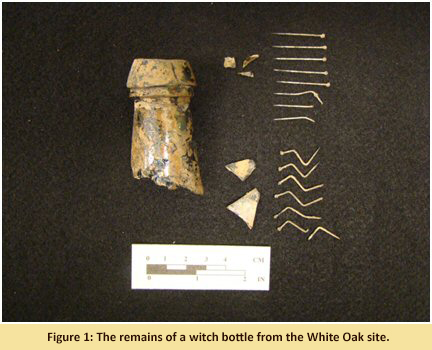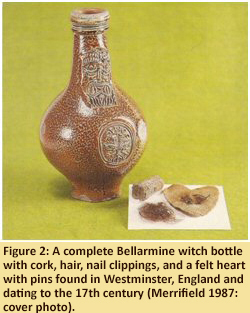Witch Bottle
August 2009
By Rebecca Morehouse, MAC Lab State Curator
In January 1983, preceding construction of a wastewater treatment facility, Mid-Atlantic Archaeological Research, Inc. (MAAR) conducted Phase I and II archaeological investigations at the University of Maryland
Center for Environmental and Estuarine Studies at Horn Point in Dorchester County, Maryland. One of the sites identified during these excavations was the White Oak site, a tenant house or possible
slave quarter, which dates to the mid-19th to early 20th centuries (Schiek and Goodley 1984: II-17).
 A wine bottle neck (Figure 1) was recovered from a hearth or chimney at the rear of a brick structure at the White Oak site (Schiek and Goodley 1984: II-4). While wine bottle glass is far from uncommon
on domestic sites, this bottle neck had special significance because, when excavated, it "contained a portion of a solid stopper into which had been inserted, on both the inside and the outside, nickel-plated
copper straight pins" (Schiek and Thomas 1983: II-3). This collection of objects indicated archaeologists had found the remains of a "witch bottle".
A wine bottle neck (Figure 1) was recovered from a hearth or chimney at the rear of a brick structure at the White Oak site (Schiek and Goodley 1984: II-4). While wine bottle glass is far from uncommon
on domestic sites, this bottle neck had special significance because, when excavated, it "contained a portion of a solid stopper into which had been inserted, on both the inside and the outside, nickel-plated
copper straight pins" (Schiek and Thomas 1983: II-3). This collection of objects indicated archaeologists had found the remains of a "witch bottle".
Originating in Europe several hundred years ago, witch bottles were protective "white magic" charms used to ward off "black magic" or were used
as countermeasures to redirect an evil spell back on the conjurer. A witch bottle, usually made using a glass bottle or ceramic jug, was filled with urine and sharp objects, such as pins or nails,
and buried inverted at the entrance to a home or under a hearthstone (Becker 1980: 20-21; Merrifield 1987: 163-175). Urine was the most important ingredient in witch bottles, as it is the agent with which
the spell is turned back upon the witch (Figure 3). The sharp objects may have been symbolic of the victim's pain, and inverting the bottle when buried symbolized the reversing of the
witch's black magic (Becker 1980: 20-21).
 The witch bottle from the White Oak site (Figure 1) is broken and incomplete. At some point in the past, the main body and base of the bottle was destroyed, leaving only the bottle's neck and lip and the pins. Any urine that may have been present in the bottle would have been absorbed into the surrounding soil when the bottle was broken or it may have slowly leaked from the bottle as the sealed stopper
began to degrade. It was recovered from a layer which also contained melted green bottle glass, bone, and a horse shoe (Schiek and Thomas 1983: II-3). Some of the bottle glass may have been part of the
original bottle and the bone and horseshoe may have been associated with the ritual burial, as bone and iron, usually in the form of nails, have been found with witch bottle burials from the 17th and
18th centuries in both America and England (Becker 2005: 18). Also, in folk practice, iron in any form holds its own protective powers.
The witch bottle from the White Oak site (Figure 1) is broken and incomplete. At some point in the past, the main body and base of the bottle was destroyed, leaving only the bottle's neck and lip and the pins. Any urine that may have been present in the bottle would have been absorbed into the surrounding soil when the bottle was broken or it may have slowly leaked from the bottle as the sealed stopper
began to degrade. It was recovered from a layer which also contained melted green bottle glass, bone, and a horse shoe (Schiek and Thomas 1983: II-3). Some of the bottle glass may have been part of the
original bottle and the bone and horseshoe may have been associated with the ritual burial, as bone and iron, usually in the form of nails, have been found with witch bottle burials from the 17th and
18th centuries in both America and England (Becker 2005: 18). Also, in folk practice, iron in any form holds its own protective powers.
Witch bottles, like the one from the White Oak site, are evidence that folk magic, deeply rooted in European traditions, was alive and well, not just in the early years of the colonies, but well into
the 19th and even the 20th centuries. While such efforts may seem amusing to us in the 21st century, witch bottles represent "the poignant efforts of a pre-scientific era" to protect itself from
what were perceived as very real threats. (Becker 1980: 23).

| References |
|
| Becker, Marshall Joseph |
| 1980 |
An American Witch Bottle. Archaeology 33 (2): 18-23. |
| 2005 |
An Update on Colonial Witch Bottles. Pennsylvania Archaeologist 75 (2): 12-23. |
|
| ph |
| 1671 |
Astrological Practice of Physick. Lon |
| don. |
|
| Merrifield, Ralph |
| 1987 |
The Archaeology of Ritual and Magic. London: B. T. Batsford Limi |
| ted. |
|
| Schiek, Martha J. and Ronald A. Thomas |
| 1983 |
Archaeological Study for the Step II Engineering Services at the University of Maryland Center for Environmental and Estuarine Studies at Horn Point, Dorchester County, Maryland. Newark, Delaware: Mid-Atlantic Archaeological Research, Inc. |
|
| Schiek, Martha J. and Edward C. Goodley |
| 1984 |
Archaeological Site Examination: 18DO129, Dorchester County, Maryland. Newark, Delaware: Mid-AtlanticArchaeological Research, Inc. |
|